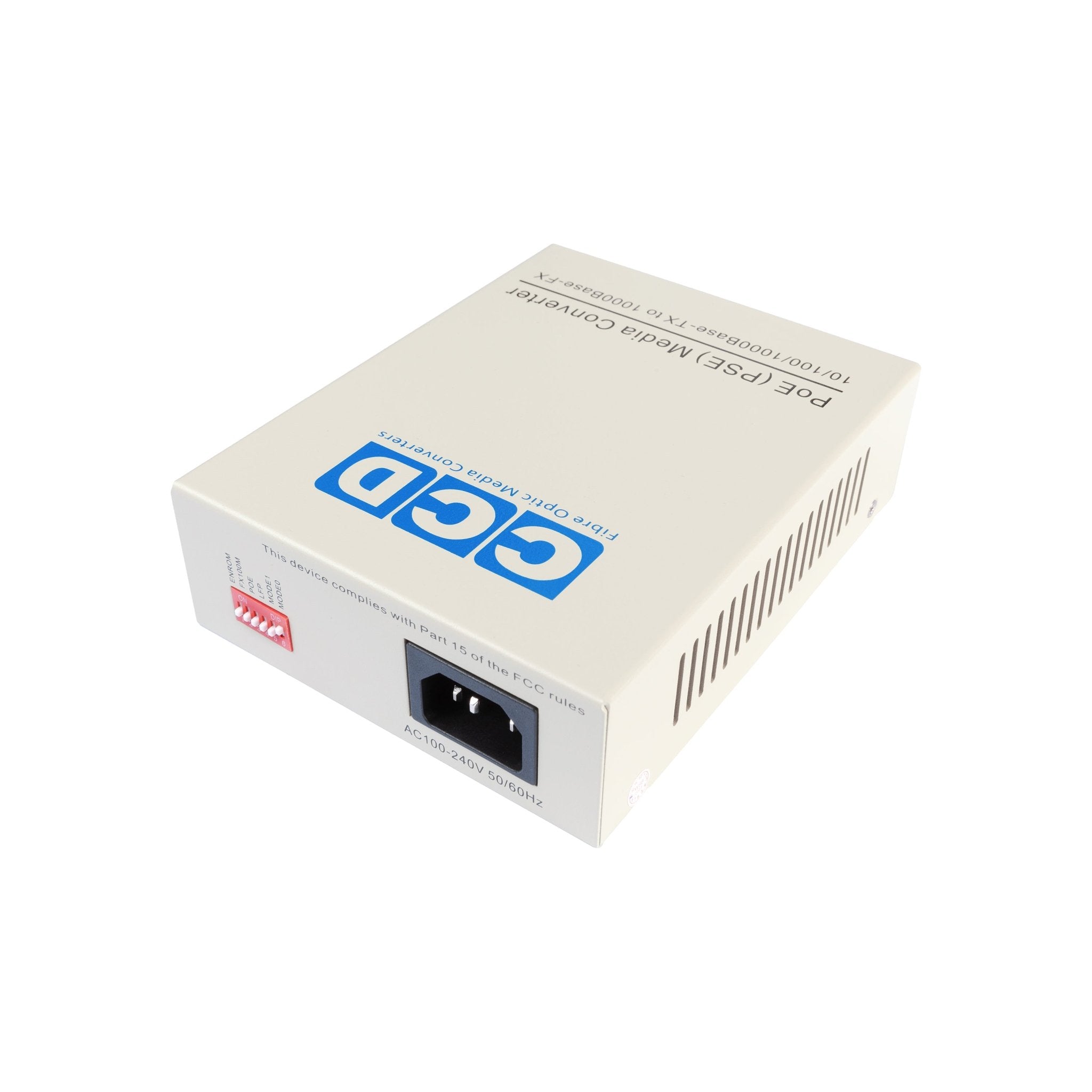



CCD-POE-4100 Fibre Optic Gigabit Media Converter
GST Inclusive

CCD-POE-4100 series is a Power over Ethernet Gigabit Ethernet Media Converter that transforms copper-based 10/100/1000Base-TX signals into optical signals for 1000Base-X connections. It can reach network transmission ranges up to 550m, or up to 80km, depending on the fibre type and wavelength.
Specifications:
- Standard Protocol: IEEE 802.3i, IEEE 802.3u, IEEE 802.3ab, IEEE 802.3z , IEEE 802.3at/af.
- POE Power Output: 15.4 Watts (IEEE 802.3af) / 30 Watts (IEEE 802.at)
- Power Consumption: 34 Watts with IEEE 802.3at 30 Watt Full Load
- TP Port: Auto-negotiation and automatic MDI/MDIX crossover detection.
- Performance: 1Mbit frame buffer memory.
- Switching Mode: Store and forward switching.
- Wavelengths: 850nm, 1310nm, 1550nm.
- Transmission: Multi-Mode or Single-Mode.
- LEDs: PWR, TX-LNK, TX-ACT, FX-LNK, FX-ACT, FDX.
- Connectors: RJ-45 alongside SFP, SC, or ST inputs.
- Power: 100-240V AC input, 48V DC 0.54A output.
- Power Supply: Internal
- Operating temperature: 0°C to 50°C
- Humidity: 5-90%
- Dimensions: 140mm x 110mm x 40mm
- 5-Year Warranty
- Removable SFP included with SFP/LC models.

Frequently Asked Questions
How long does shipping take?
Orders can take 3-14 business days to arrive, depending on stock levels and your location.
What is a Media Converter?
A media converter is a networking device that converts one type of network media, such as copper network cabling, to another, such as fibre optic network cabling. This is often used to extend network distances or connect different network types.
What is the difference between Single-Mode and Multi-Mode?
Single-mode fibre uses a thin core to guide light in a single path, enabling long-distance, high-bandwidth transmissions. Multi-mode fibre, on the other hand, has a thicker core that allows multiple light paths to travel simultaneously. While this can increase bandwidth over shorter distances, it can also lead to signal distortion due to the different light paths arriving at different times. This makes multi-mode fibre more suitable for shorter-distance applications, while single-mode fibre is better suited for longer-distance transmissions.
What is an SFP module?
An SFP module is a small, hot-swappable device that plugs into media converters, network switches, and routers. It provides various connectivity options, such as fibre optic or copper connectors.
Can I mix and match different brands of SFP modules?
While it's generally possible to mix and match SFP modules from different brands, it's recommended to consult the manufacturer's compatibility guidelines to ensure optimal performance and avoid potential issues.
What is the difference between CAT5e, CAT6, and CAT7 cables?
These are different categories of Ethernet cables, with each category offering higher speeds and better performance than the previous one. CAT7 is the latest and fastest category.
How do I choose the right Media Converter for my network?
Consider factors like the distance you need to cover, the data rates required, and the type of media you're converting between. Consulting with a network professional can help you make the best choice.
Fibre Optic vs Copper Cables
Fibre optic cables use light pulses to transmit data, offering higher bandwidth, longer transmission distances, and immunity to electromagnetic interference. Copper cables use electrical signals, are less expensive but have limitations in distance and bandwidth, and are more susceptible to interference.
Can I use a CAT6 cable with a CAT5e port?
While you can use a CAT6 cable with a CAT5e port, the performance will be limited by the older port. The CAT6 cable's higher capacity won't be fully utilized.
What is the difference between duplex and simplex modes?
Duplex mode enables simultaneous data transmission and reception in both directions, while simplex mode allows data transmission in only one direction at a time.
What is PoE (Power over Ethernet)?
PoE technology transmits electrical power along with data signals over Ethernet cables, eliminating the need for separate power outlets and simplifying network installations, especially for devices like IP cameras and VoIP phones.



